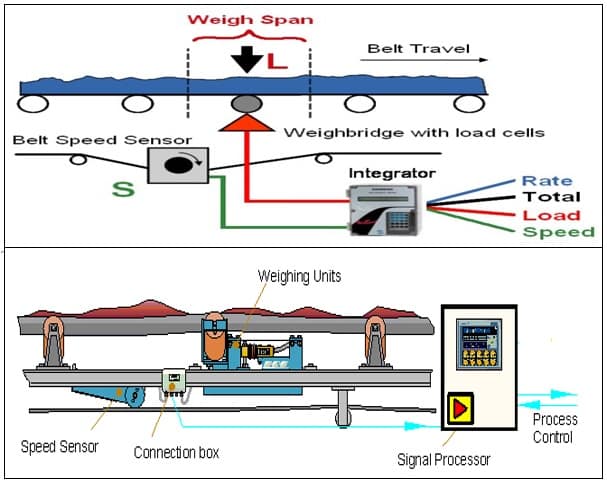For weighing conveyor system material, belt weigher or conveyor belt scale are used. These scale determines the rate at which material travels on a conveyor belt over a specific period of time.
Conveyor Belt Scale or Belt Weigher Working Principle

A typical conveyor belt scale or belt weigher system has a weigh bridge structure supported on load cells, an electronic integrator, and a belt speed sensor.
The load cells measure the material weight on the belt, and send a signal to the integrator. The integrator also receives input in the form of electrical pulses from a belt speed sensor. Using these two sources of data, the integrator calculates the rate of material transferred along the belt using the equation:
weight x speed = rate.
Where Should You Install a Conveyor Belt Scale or Belt Weigher?
To attain accurate measurements and minimize any disruption in working processes, it is important to choose a suitable location for the installation of a conveyor belt scale. Below are a few points to help you select the best location for installing a conveyor belt scale:
- Never install a belt scale near the materials loading point
- Choose an area with constant belt tension
- A steep incline is a poor location choice
- Avoid locations where the conveyor forms a convex or concave curve
- Consider vibration & weather
Preventive Maintenance of Conveyor Belt Scale or Belt Weigher
Work involved during preventive maintenance of belt scale or belt weigher:
- Cleaning of integrator using a mild cleaner and soft rag.
- The load cell assemblies, speed sensor, and angle are washed with low pressure water and mild soap.
- Inspection of scale components for damages.
- Cables inspection for pinches or breaks.
- Load cells visually checking for material build -up.
- Speed sensor wheel sound checking for wear.
- Correction of identified problems.
RELATED SEARCHES:
Types and working of load cell
Working of weigh bridge or truck scale
